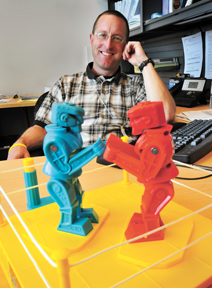
Many of the things you use at Sandia to do your job and the benefits you receive to improve your life came to Sandia using a new process — dynamic bidding events, better known as reverse auctions.
In a dynamic bidding event, a proposal for a good or service is set up for bid starting with a maximum target price. Vendors bid down on price until the last bid (and usually the lowest price) results in a winner at the event’s expiration time.
“This process heightens competition by making the process exciting,’’ says procurement manager Doug Otts (10242). And anything procured competitively, he says, could be procured this way. The process allows Sandia to have “a near-perfect assessment of the market for our business,” he says. “True dynamic bidding events such as ours get us as close to pure competition as possible by giving us a solid understanding of what prices the market will truly bear for the goods and services Sandia needs.”
To prepare vendors for this new bidding process, Doug holds mandatory training sessions for potential vendors via live “test events” prior to the actual event. During these test events, vendors practice submitting price proposals and bids using a fictional product or service.
In preparation for a dynamic bidding event, vendors are first given a technical proposal that explains in detail the item or service being requested by Sandia. In the case of services, sometimes those proposals can be lengthy. The proposal ensures that each vendor will provide a homogeneous product or service with similar benefits.
Sandia places a request for goods or services up on a website in advance of the set bid event time. On the day of the event, vendors log in at a preappointed time. The event opens, and bidders offer progressively lower rates for similar products until the auction times out and the final prices submitted by each bidder are locked in. Each event typically lasts a half an hour but can be scheduled to run for much longer depending on the complexity of the product or service being procured.
When the event closes, the vendor providing the “best value” bid wins the contract. “The lowest-priced bid doesn’t always win,” Doug notes, “because the lowest price is not always the best value.”
Since this is a relatively new process at Sandia, procurement has trained all of Sandia’s contracting representatives (SCRs) in the specifics of conducting an auction. SCRs practice submitting proposals to repair a Rock ’em Sock ’em Robots game that Doug keeps on his desk. Each participant submits a repair proposal and goes through a mock Rock ’em Sock ’em Robot repair proposal process.
Doug believes that dynamic bidding events shorten bidding time, which “makes it exciting for vendors, gives all a true assessment of the marketplace, and heightens competition for Sandia’s business.” This process, Doug says, typically shaves between 8-20 percent off Sandia’s costs for items and services procured via this tool.
The first dynamic bidding event successfully completed at Sandia was for Sandia’s copier fleet, which was for millions of dollars and was completed in the early 1990s. The 10 events completed so far have saved Sandia nearly $10 million. Most recently, Sandia has set up dynamic bidding events for some of its benefits plans, including the recently completed procurement for administrative services of Sandia’s Vision Plan, which was won by Davis Vision. An event was also recently completed for the acquisition of the Labs’ Microsoft Product Enterprise licenses, which is worth an estimated $12.5 million over five years.
Sandia is also participating actively in the Supply Chain Management Center, an NNSA complex-wide transformation group, whose focus is on creating efficiencies across the Supply Chain.
Doug is a second-generation Sandian. His father, John Otts, oversaw the building of Sandia’s Solar Tower in the 1970s. Doug often went to work with his father as the tower was being built, and he now has a picture hanging on his wall of the tower’s first test. The melted metal plate from that first test also sits in his office.
After completing his MBA more than 14 years ago, Doug was excited to come to work at Sandia, but he “didn’t know what procurement meant.” Now he embraces the dynamic bidding process as an efficient way to procure products and services and help keep Sandia’s costs down.